A short drive around Chico will reveal that lawn is a prominent landscape feature for the majority of homes. Yet we seldom see people outside using their front lawns. Maintaining a lawn just to view wastes time, energy, water and money. According to a 2011 study sponsored by the California Department of Water Resources (“California Single Family Water Use Efficiency Study”), the average household uses 360 gallons of water per day, around 50% of it outdoors. Replacing lawn with waterwise landscaping can reduce outdoor water use by 30-70%. In addition, lawns need mowing, fertilizing and weeding.
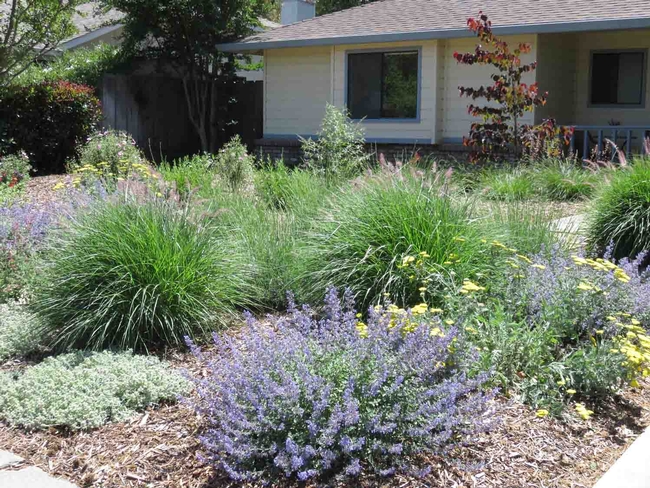
Start with hardscaping: walkways, gravel paths, small patios or decks, dry creek beds and retaining walls. These provide visual interest and reduce irrigated areas. Plan a pleasing and obvious walkway to your front door. You can edge it with intervals of plantings, in the ground or in urns. Meandering gravel paths provide a functional and low-cost way to move about the garden. A small patio invites you to relax. Dry creek beds and small retaining walls separate planting areas and provide elevation changes. You can also use an edging of stone or brick to separate planting areas.
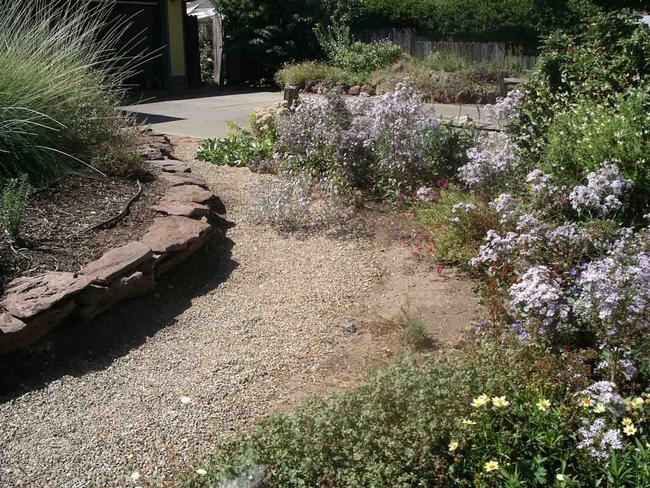
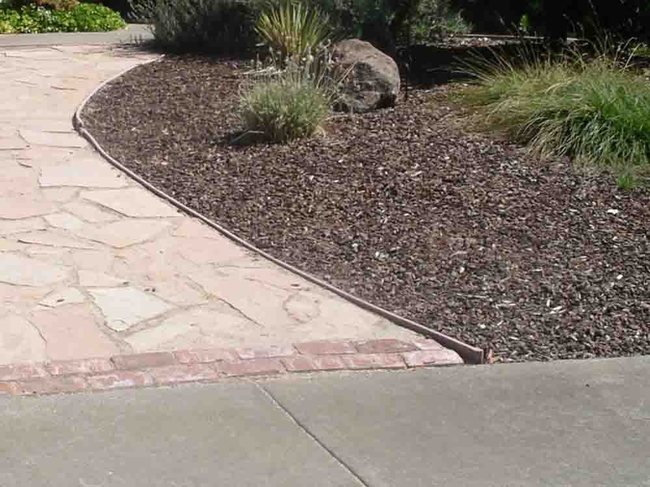
The New Sunset Western Garden Book and Calscape (California Native Plant Society's database of native plants) provide information about waterwise plants. If your yard will include automatic irrigation, group together plants with similar water needs.
The UC Cooperative Extension WUCOLS database estimates the water needs of thousands of garden plants and is a valuable tool for grouping plants into hydrozones.
Consider adding focal points. A water feature attracts birds to the garden. It can be as elaborate as a fountain or as simple as a ceramic dish. Large boulders also provide visual interest. A bench flanked by large pots of colorful flowering plants invites you to sit and enjoy your garden.
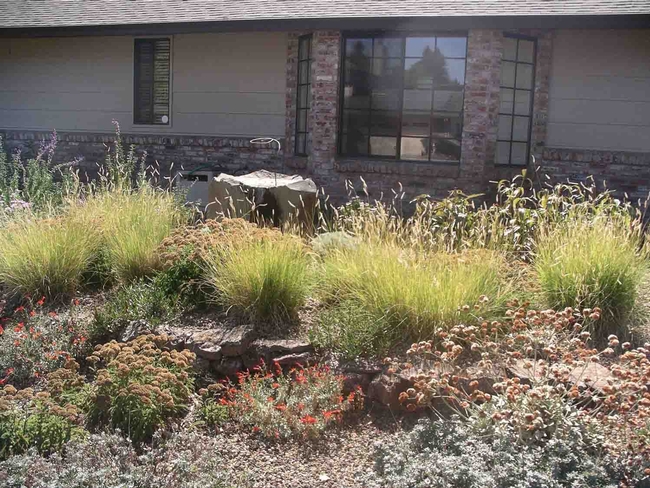
Visit the Master Gardener Demonstration Garden at Patrick Ranch (10381 Midway in Durham) to see a variety of gardens that are waterwise, interesting and beautiful without relying on areas of lawn. Our gardens are free to visit and are open whenever Patrick Ranch is open to the public.

By Alicia Springer, UC Master Gardener of Butte County, November 30, 2018
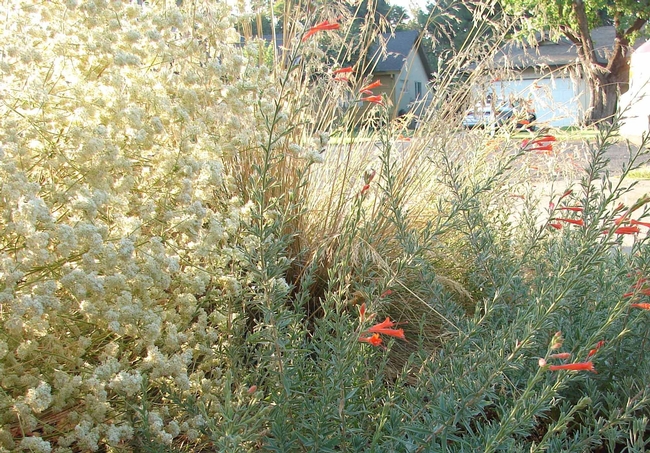
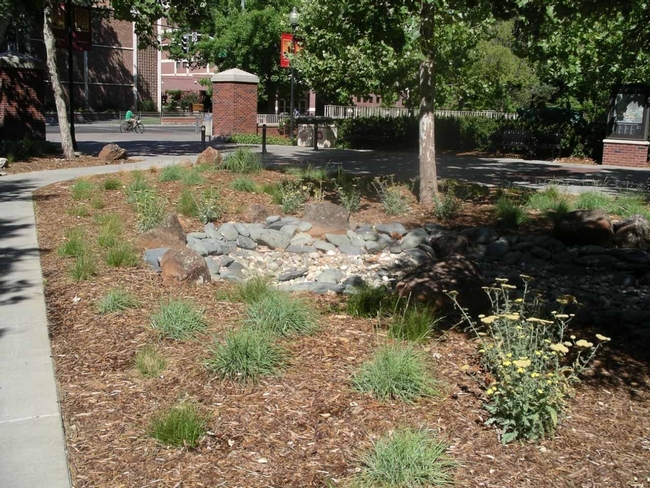
Note that our merciless summers require additional irrigation for even drought-tolerant native plants while they are getting established. A spare but regular drip-irrigation line for the first two summers will improve survival rates.
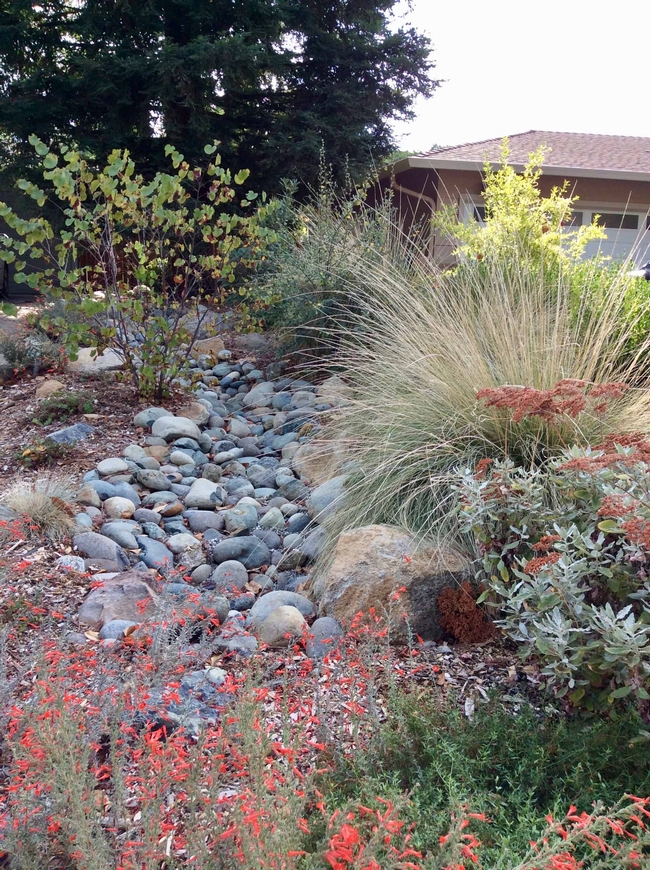
- Sedges (Carex species) and rushes (Juncus species) for sun
- Yerba buena (Clinopidium douglasii) for part-shade
Deep-rooted, larger grasses to anchor:
- Deer grass (Muhlenbergia patens)
- Native fescues (Festuca californica, F. idahoensis, F. rubrica)
- Creeping wildrye (Leymus triticoides)
Perennials that tolerate winter moist, summer dry conditions:
- Douglas iris (Iris douglasii)
- California fuchsia (Epilobium canum)
- Prostrate manzanita (Arctostaphylos uva-ursi)
- Buckwheats (Eriogonum species)
- Fleabane daisies (Erigeron species)
- Yarrow (Achillea millefolium)
- Common monkeyflower/aka sticky-monkey (Mimulus aurantiacus)
- Yellow monkeyflower/aka seep mimulus (Mimulus guttatus)
- California coneflower (Rudbeckia californica)
- Hummingbird sage (Salvia spathacea) and other salvia species
Drought-tolerant ferns for shade
- Polypody fern (Polypodium californicum)
- Western sword fern (Polystichum munitum)
- Wood fern (Dryopteris arguta)
Shrubs and small trees for banks
- Hybrid rockrose (Cistus skanbergii)
- Barberry (Berberis aka Mahonia pinnata)
- Toyon (Heteromeles arbutifolia)
- California coffeeberry (Rhamnus californica)
- Gooseberry (Ribes speciosum)
- Wood rose (Rosa gymnocarpa)
- St. Catherine's Lace (Eriogonum giganteum)
- Redbud (Cercis occidentalis)
- Mountain mahogany (Cercocarpus betuloides)
- Red twig dogwood (Cornus sericea)
- Ceanothus species
- Manzanitas (Arctostaphylos species)
For more information on gardening in our area, visit the Butte County Master Gardener web page at: http://ucanr.edu/sites/bcmg/. If you have a gardening question or problem, call our Hotline at (530) 538-720l.
By Cindy Weiner, UC Master Gardener of Butte Count, November 16, 2018
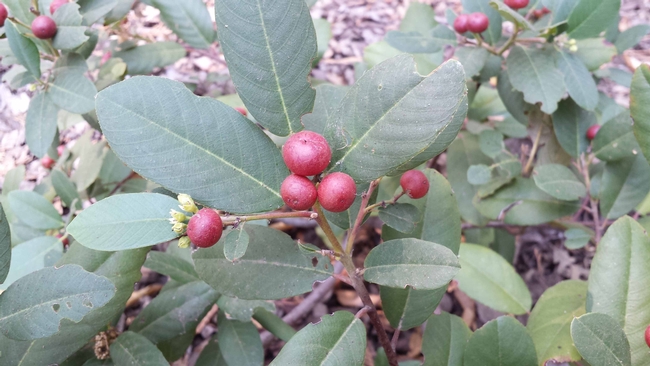
Eve Werner, landscape architect and owner of Eve's Garden Design, likes to use coffeeberry (Frangula californica) as a screen, background or hedgerow. Its blackish berries resemble coffee beans and are very attractive to birds. This evergreen shrub can grow to six to ten feet tall and wide although the cultivar ‘Eve Case' is smaller, only reaching about five feet. It is native to Butte County and grows in Upper Bidwell Park. Werner says, “This adaptable plant thrives in full sun to shade with monthly to no summer irrigation.”
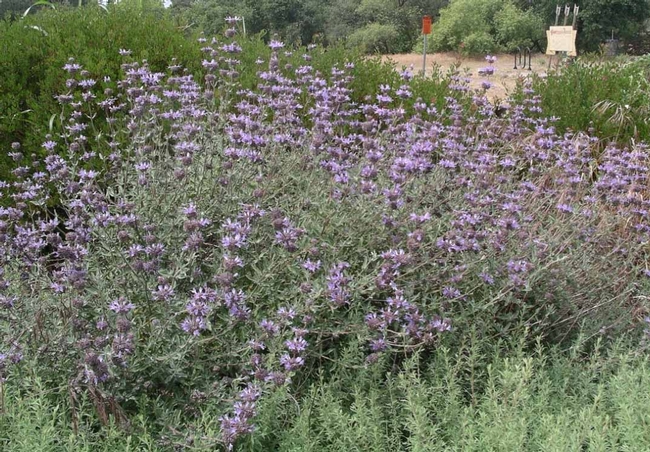
Jason Mills, owner of Ecological Solutions, suggests, “If you're looking for an evergreen shrub, why not try giving the local and less commonly used hollyleaf redberry (Rhamnus ilicifolia) a shot?” Hollyleaf redberry has small serrated leaves, resembling holly. It grows best in full sun or partial shade. The flowers are small and inconspicuous but develop into beautiful red fruit, which provide food for birds. It grows five to ten feet tall and needs no summer water once established.
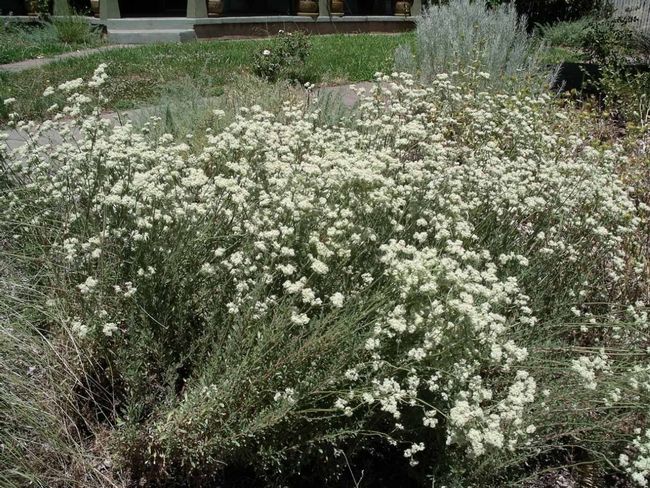
Mills and Whittlesey like using the large perennial bunch grass deergrass (Muhlenbergia rigens). Whittlesey says, “I use deergrass to bring a rhythm and flow into a garden. When in flower in later summer, it has a stronger architectural form which holds through the winter months. It combines readily in front of larger shrubs or as a foil for small shrubs and perennials.” Deergrass forms a dense clump to 4 feet tall and wide in full sun or light shade.
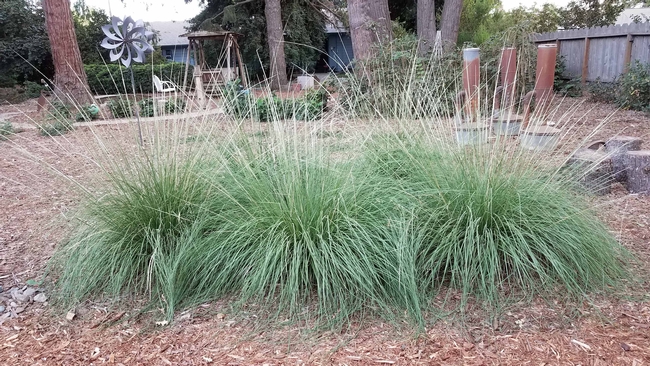
By Cindy Weiner, UC Master Gardener of Butte County, June 15, 2018
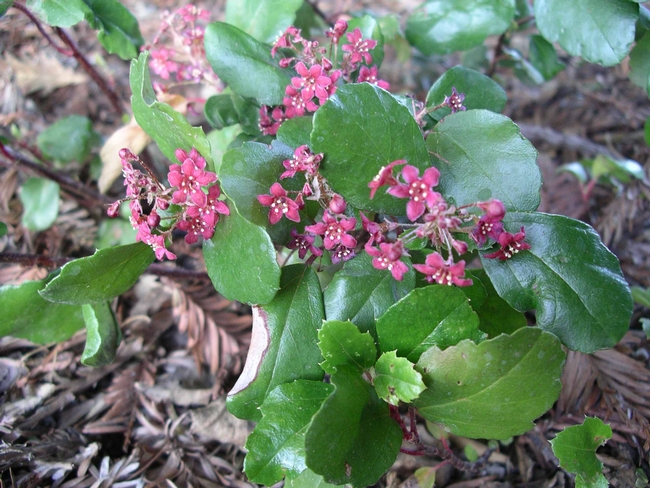
One plant suitable for dry shade is Catalina perfume or evergreen currant (scientific name Ribes viburnifolium). Native to Catalina Island and Baja California, it is a small evergreen shrub with glossy dark green leaves that have a spicy fragrance. The arching red stems reach 3 feet tall and spread about 6 feet. Pruning the stem tips will increase the density of the plant. Small rose-colored flowers appear from February to April. The fruit, a reddish-orange berry, isn't commonly seen in garden settings. While Catalina perfume needs no supplemental water once established, it can tolerate more, so it can be grown alongside plants with greater water requirements.
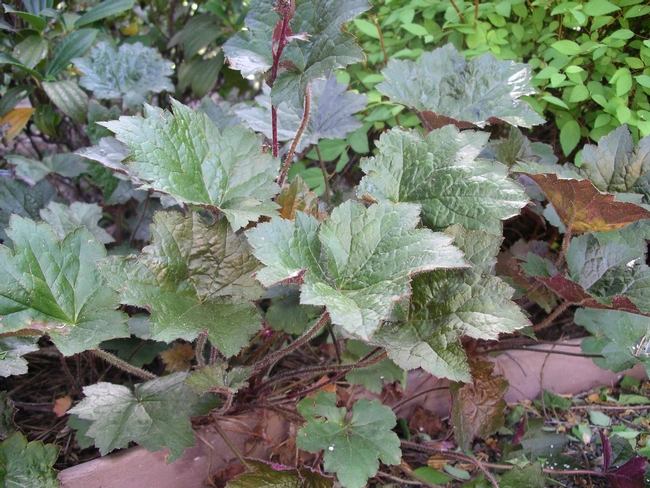
Island alum root (Heuchera maxima) is native to the Channel Islands. It grows one to three feet tall and has creamy white to pinkish flowers. Crevice alumroot (Heuchera micrantha) grows on rocky mountain outcrops from central California north to Oregon. It is smaller than island alum root and its flowers are white or pink. Many cultivars of crevice alum root are available in general nurseries. These cultivars have been selected for foliage with silvery, bronze or purple tones. Three of the cultivars are “painted lady,” “Blessingham bronze,” and “purple palace.”
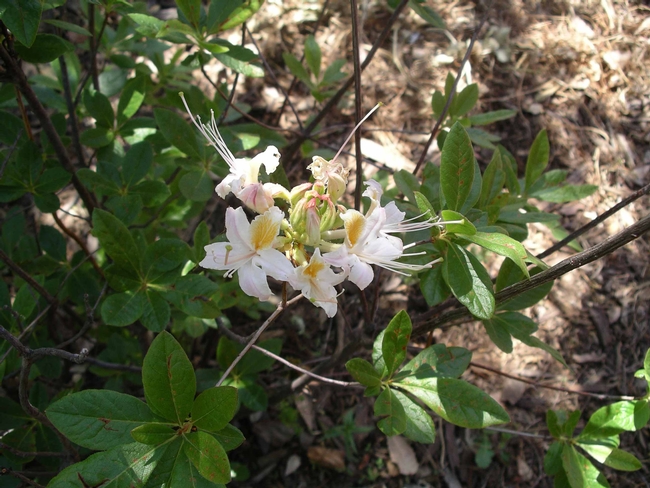
For more information on gardening in our area, visit the Butte County Master Gardener web page at: http://ucanr.edu/sites/bcmg/. If you have a gardening question or problem, call our Hotline at (530) 538-7201.
By Cindy Weiner, Butte County Master Gardener, July 29, 2016.
One approach to dealing with drought conditions in the garden is to turn to native plants that are well-acclimated to our local environment. Some gardeners new to planting natives may be concerned that these plants might require special care, but in general they need not worry. While some natives can be difficult in the garden, most are not, and many are very easy to grow. Three local landscape designers specializing in native plants offer the following suggestions for “no fail natives.” In addition to being easy to care for, these particular plants give a threefold return on one's investment: they are attractive, versatile, and provide valuable support for wildlife in the garden.
Eve Werner, landscape architect and owner of Eve's Garden Design, likes to use coffeeberry (Frangula californica) as a screen, background or hedgerow. Its blackish berries resemble coffee beans and are very attractive to birds. This evergreen shrub can grow to six to ten feet tall and wide although the cultivar ‘Eve Case' is smaller, only reaching about five feet. It is native to Butte County and grows in Upper Bidwell Park. Werner says, “This adaptable plant thrives in full sun to shade with monthly to no summer irrigation.”

Jason Mills, owner of Ecological Solutions, suggests, “If you're looking for an evergreen shrub, why not try giving the local and less commonly used hollyleaf redberry (Rhamnus ilicifolia) a shot?” Hollyleaf redberry has small serrated leaves, resembling holly. It grows best in full sun or partial shade. The flowers are small and inconspicuous but develop into beautiful red fruit, which provide food for birds. It grows five to ten feet tall and needs no summer water once established.
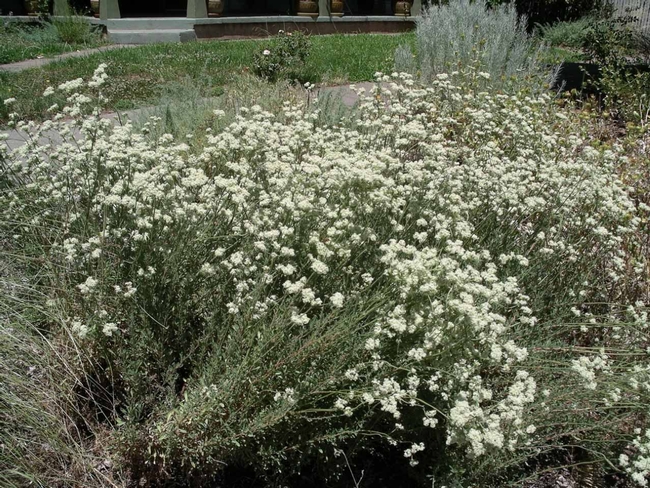
Mills and Whittlesey like using the large perennial bunch grass deergrass (Muhlenbergia rigens). Whittlesey says, “I use deergrass to bring a rhythm and flow into a garden. When in flower in later summer, it has a stronger architectural form which holds through the winter months. It combines readily in front of larger shrubs or as a foil for small shrubs and perennials.” Deergrass forms a dense clump to 4 feet tall and wide in full sun or light shade.
Growing natives can be easy if you give careful consideration to the plant's cultural requirements. Mills states, “In the end it all comes down to putting the right plant in the right spot. We look to nature and try to match the conditions (substrate, moisture, light exposure) found in remaining intact habitats when we create our designs and implement native landscapes. When you get it right, you'll know, as they thrive for years to come with little to no water and maintenance and provide crucial resources for wildlife along the way.”


